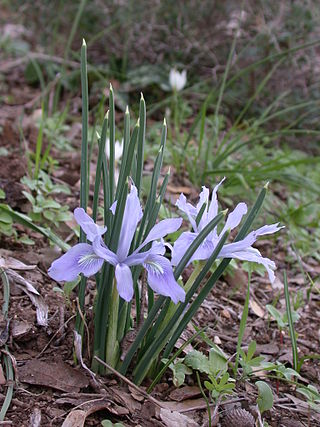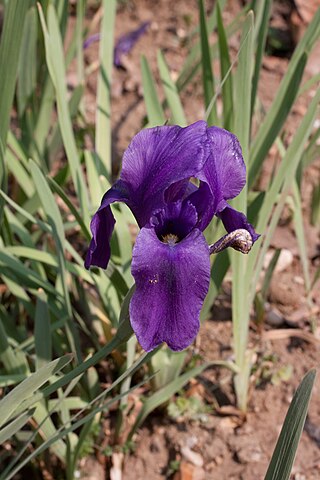
Iris japonica, commonly known as fringed iris, shaga and butterfly flower, is a native of China and Japan. It is a species in the genus Iris, in the subgenus Limniris and within the Lophiris section. It is a rhizomatous perennial plant, with pale blue, lavender or white flowers with an orange or yellow crest. It is cultivated as an ornamental plant in temperate regions.

Iris aucheri, the Aucher-Éloy iris, is a species of flowering plant in the family Iridaceae. It is a bulbous perennial in the Juno group of irises.
Iris tenuis is a plant species in the genus Iris, subgenus Limniris. It is a rhizomatous perennial, endemic to Clackamas County, Oregon. The flowers are white, pale blue or lilac, with a yellow or golden low dissected crest and pale green leaves. It is cultivated as an ornamental plant in temperate regions.

Iris vartanii is a plant species in the genus Iris. It is classified in the subgenus Hermodactyloides and section Reticulatae. It is a bulbous perennial.

Iris palaestina is a species in the genus Iris in the subgenus Scorpiris. It is a bulbous perennial from Asia, including the Palestine region, Lebanon, Syria and Turkey. It has long, narrow, strap-like leaves, and a short stem. The early blooming, fragrant flowers are greenish-grey/white or yellow-white.

Naomi Feinbrun-Dothan was a Russian-born Israeli botanist, who became part of the academic staff at the Hebrew University of Jerusalem. She studied the flora of Israel and published dozens of articles and several analytical flora books. Just after her 91st birthday, she received the 1991 Israel Prize for her unique contribution to the Land of Israel studies.

Iris grant-duffii is a species in the genus Iris. It is also in the subgenus Limniris and in the series Syriacae. It is a rhizomatous perennial, from Lebanon, Israel, Syria, Turkey, Lebanon and Iraq, which has brown bristles/spines on the rhizome, long thin greyish green leaves, short stem carrying a single scented flower in shades of yellow.
Iris afghanica is a plant species in the genus Iris, it is also in the subgenus Iris and in the section Regelia. It is a rhizomatous perennial, from Afghanistan, with thin bluish-green leaves and creamy yellow or white flowers, that are veined with purple-brown. It has yellow-green or purple beards. Although, in the wild, it can vary in colour and size. It is cultivated as an ornamental plant in temperate regions.
Iris heweri is a plant species in the genus Iris, it is also in the subgenus Iris and in the section Regelia. It is a rhizomatous perennial, from Afghanistan. It has tall, green curved leaves, tall slender stems and purple blue or violet-blue flowers, with white and purple or lilac beard. It is cultivated as an ornamental plant in temperate regions.

Iris hoogiana is a plant species in the genus Iris, it is also in the subgenus Iris and in the section Regelia. It is a rhizomatous perennial, from the grassy mountainsides of Turkestan. It has long green leaves, which are slightly purple at the base, and a long slender flowering stem. The flowers are blue, ranging from sky-blue to lavender blue and blue purple. It has orange or yellow beards. It is cultivated as an ornamental plant in temperate regions.
Iris sikkimensis is a plant species in the genus Iris, it is also in the subgenus Iris and in the section Pseudoregelia. It is a rhizomatous perennial, from Sikkim. It has pale green or light green thin leaves, slender stem, 2 or 3 lilac or purple flowers, with a white beard with orange tips. It is thought to be a hybrid of Iris hookeriana and Iris kumaonensis.

Iris atrofusca is a species in the genus Iris, where it is placed in the subgenus Iris and the section Oncocyclus. It is a rhizomatous perennial from the deserts of Israel and Jordan. The species has long falcate (sickle-shaped) or ensiform (sword-shaped) leaves, a long thick stem and large fragrant flowers that come in shades of purple brown, reddish-black, black-brown, dark brown, dark lilac or dark purple. The flowers also have a black or brownish-black signal patch and a thick beard that is brown-black, light brown or yellow tipped with brown. It is rarely cultivated as an ornamental plant in temperate regions.

Iris atropurpurea, the coastal iris is a species in the genus Iris, it is also in the subgenus of Iris and in the section Oncocyclus. It is a rhizomatous perennial, from Israel. It has glaucous (blue-green), linear, falcate (sickle-shaped) leaves. Between February and March, it has between 1 and 2 flowers, in dark shades from red-brown, burgundy, dark purple to blackish purple. They have a darker signal patch and yellow beard tipped with purple. It is rarely cultivated as an ornamental plant in temperate regions, due to it needing very dry conditions.

Iris bismarckiana, the Nazareth iris, is a species in the genus Iris, it is also in the subgenus Iris and in the section Oncocyclus. It is a rhizomatous perennial, from the mountainsides of Israel, Lebanon, Jordan and Syria. It has stoloniferous, spreading rhizomes, long, sword shaped, bright green leaves, long slender stem and 1 flower in Spring. The large flower is pale yellow, creamy-white, or white background. Which is covered with reddish-brown, maroon brown, purple-brown, purple, blue-purple, or blue veins, markings or spots. It has a dark signal patch and dark purple to black beard. It is rarely cultivated as an ornamental plant in temperate regions, as it needs very dry conditions during the summer.

Iris bostrensis is a species in the genus Iris, it is also in the subgenus Iris and in the section Oncocyclus. It is a rhizomatous perennial, from the border between Syria and Jordan. It has greenish-grey leaves, 1–2 flowers in Spring,, which have a yellowish, greenish or pale brown ground, which is then covered in many brown-black, brown-purple, or brown, spots, streaks or veining. It has a bright yellow beard, slightly tipped in purple. It is rarely cultivated as an ornamental plant in temperate regions, due to its environmental conditions of its natural habitat.
Iris camillae is a species in the genus Iris, it is also in the subgenus Iris and in the section Oncocyclus. It is a rhizomatous perennial, from Azerbaijan. It has narrow, falcate (sickle-shaped) leaves, medium-sized stem and large flowers, where the flower colour is very variable, ranging from violet, purple, pale blue, and also yellow, and occasionally bi-colour forms are found. It has a yellow beard. It is rarely cultivated as an ornamental plant in temperate regions, due to its environmental conditions of its natural habitat.

Iris hermona, the Golan iris, is a plant species in the genus Iris, it is also in the subgenus of Iris, and in the section Oncocyclus. It is a rhizomatous perennial, from the pastures and meadows of the Golan Heights in Israel and Syria. It has linear, upright leaves, tall slender stem holding a bi-coloured flower, having a pale lilac, cream-yellow, light tan, or white background, which is then covered in purple brown, or purple, or purple-pink veining, spots or speckling. It has a round purple-brown or almost black signal patch, and a sparse purple brown or almost black beard. It is rarely cultivated as an ornamental plant in temperate regions, as it needs very dry conditions during the summer.
Iris heylandiana is a species in the genus Iris, it is also in the subgenus Iris, and in the section Oncocyclus. It is a rhizomatous perennial, from the marshlands or fields of Iraq. It has short, linear or sickle shaped grey-green leaves, slender stem, a single flower in spring, which has a dingy-white, whitish, or pale background, which is covered in many spots or dark veining, in black-purple, brown-purple, or brown violet, or brown shades. It has a dark brown or burgundy brown signal patch and white tinged with yellow or orange white sparse beard. It is rarely cultivated as an ornamental plant in temperate regions, as it needs very dry conditions during the summer.

Iris lortetii is a species in the genus Iris. It has straight grey-green leaves, a 30–50 cm tall stem, and large showy flowers in late spring or mid-summer that come in shades of pink, from white, lilac, pale lavender and grey-purple. It is veined and dotted pink or maroon. It has a signal patch that is deep maroon and a sparse and brown, purple-brown or reddish beard.

Iris petrana, commonly known as the Petra iris, is a species in the genus Iris, it is also in the subgenus of Iris and in the Oncocyclus section. It has spring blooming flowers that come in shades from burgundy, dark brown to dark violet and purple. They have yellow or dark 'beards' and flower over sword-like grey-green leaves. It is normally found in the desert sands between the countries of Jordan and Israel.














